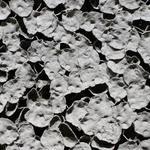2012-33
Hsu Yunghsu
徐永旭
Production date
2012
Object Detail
Media
stoneware
Measurements
210 x 152 x 42 cm
Notes
After a period of intense experimentation, by 2006 Hsu Yunghsu had arrived at his philosophical and aesthetic stance, creating works that embody his notion of ‘anti-clay’. By pushing against all previous limitations of the medium, he makes objects that transcend the limitations of weight, density and size. The large scale of his works, combined with their extreme thinness, balance mass and void, creating articulated tactile surfaces of astonishing delicacy and lightness. Hsu made a commitment to work through a simple, continuous, repeated action, such as the pinching of the clay, influenced by his reading of philosophers such as Deleuze and Foucault. Yet the work itself is formed by the physical process, its form translated directly from the artist’s body and his repetitive movements — an echo also of the Jungian philosophies that informed the gestural abstract painters of the mid-twentieth century, here translated into three dimensions. As Hsu joins smaller pieces together to form larger works, he thinks about the flow of time; in the exhausting work of the studio time stops flowing smoothly and becomes ‘overlapped and distorted’, almost chaotic. He identifies with the demanding work of heavy labourers in rural Taiwan, near his home and studio. Hsu Yunghsu describes his labour as ‘like an animal, like an insect, like a spider building a nest.’
2012-33 (2012) was created with the accretion of small hollow forms, although in this case black stoneware rather than porcelain, and with an added layer of flatter shapes, so that the deeper vessel-like forms are only partially revealed. Overlapping pieces of clay on this top layer are dappled with marks left by the artist’s fingers, catching the light. Viewing Hsu Yunghsu’s works, it is impossible not to be aware of the body of the artist, but we also sense our own bodies, and the tactile experiences of moulding clay, or sand, or mud, memories from earliest childhood. The darker shapes of hollow forms behind them create a honeycombed effect. Paradoxically, though, Hsu Yunghsu’s sculptures appear to have grown organically, without human deliberation. In each work, the deep black and ethereal white clusters of forms, suspended, apparently floating on the gallery wall, evoke the fantastically sculpted, weathered rock forms in traditional Chinese gardens.
2012-33 (2012) was created with the accretion of small hollow forms, although in this case black stoneware rather than porcelain, and with an added layer of flatter shapes, so that the deeper vessel-like forms are only partially revealed. Overlapping pieces of clay on this top layer are dappled with marks left by the artist’s fingers, catching the light. Viewing Hsu Yunghsu’s works, it is impossible not to be aware of the body of the artist, but we also sense our own bodies, and the tactile experiences of moulding clay, or sand, or mud, memories from earliest childhood. The darker shapes of hollow forms behind them create a honeycombed effect. Paradoxically, though, Hsu Yunghsu’s sculptures appear to have grown organically, without human deliberation. In each work, the deep black and ethereal white clusters of forms, suspended, apparently floating on the gallery wall, evoke the fantastically sculpted, weathered rock forms in traditional Chinese gardens.
Accession number
2014.011

